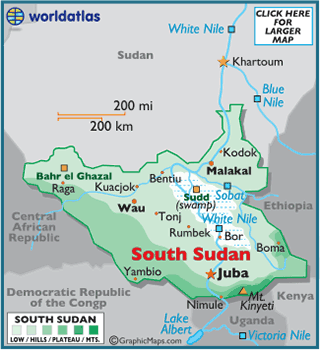 So, you don’t recall learning about South Sudan in high school history or geography? No surprise. The country was formed in 2011, less than a decade ago. In this post we take a break from our usual focus on Africa Sunrise Communities’ work. Let’s look at South Sudan as a country and how its history shapes our mission.
So, you don’t recall learning about South Sudan in high school history or geography? No surprise. The country was formed in 2011, less than a decade ago. In this post we take a break from our usual focus on Africa Sunrise Communities’ work. Let’s look at South Sudan as a country and how its history shapes our mission. 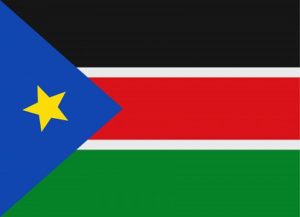 South Sudan was formed on July 9, 2011 after a referendum for independence from Sudan passed by an overwhelming majority. The country of Sudan had been formed from the Anglo-Egyptian colony of the same name and included the mostly Muslim and Arabic-speaking North along with the largely animist and Christian South, where many tribal peoples spoke their own languages and English. A long history of tension and outright fighting between peoples of the North and South finally led to this split and the founding of South Sudan.
South Sudan was formed on July 9, 2011 after a referendum for independence from Sudan passed by an overwhelming majority. The country of Sudan had been formed from the Anglo-Egyptian colony of the same name and included the mostly Muslim and Arabic-speaking North along with the largely animist and Christian South, where many tribal peoples spoke their own languages and English. A long history of tension and outright fighting between peoples of the North and South finally led to this split and the founding of South Sudan.  Many South Sudanese consider themselves part of East Africa, aligned with nations like Ethiopia, Kenya, and Uganda. As you can see from the map above, South Sudan is at a crossroads between East Africa and North Africa (Sudan, Egypt, Libya, etc.) and Central Africa (Central African Republic and Congo).The territory of South Sudan covers about 240,000 square miles, a little smaller than the state of Texas, but a population less than half of Texas. A July 2017 estimate puts the population of South Sudan at about 13,026,129 (July 2017 est.), a little larger than the population of the US state of Pennsylvania (https://www.cia.gov/library/publications/the-world-factbook/geos/print_od.html).
Many South Sudanese consider themselves part of East Africa, aligned with nations like Ethiopia, Kenya, and Uganda. As you can see from the map above, South Sudan is at a crossroads between East Africa and North Africa (Sudan, Egypt, Libya, etc.) and Central Africa (Central African Republic and Congo).The territory of South Sudan covers about 240,000 square miles, a little smaller than the state of Texas, but a population less than half of Texas. A July 2017 estimate puts the population of South Sudan at about 13,026,129 (July 2017 est.), a little larger than the population of the US state of Pennsylvania (https://www.cia.gov/library/publications/the-world-factbook/geos/print_od.html).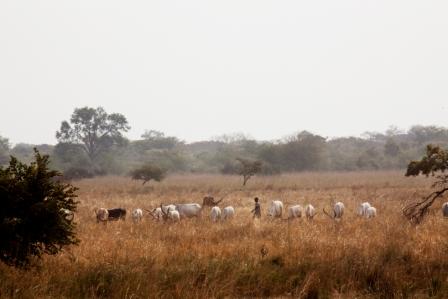 While most Americans think of “Sudan” as being a desert country, like Libya or Egypt, South Sudan is a tropical savanna with a distinct rainy season in summer and a dry season in winter. Temperatures range from 68 degrees to 98 degrees (Fahrenheit) and while most of the rains fall in the winter months, the annual rainfall for most of the country ranges from 31 to 40 inches. This leads to widespread seasonal flooding in the summer months that can cut off some villages from roads.
While most Americans think of “Sudan” as being a desert country, like Libya or Egypt, South Sudan is a tropical savanna with a distinct rainy season in summer and a dry season in winter. Temperatures range from 68 degrees to 98 degrees (Fahrenheit) and while most of the rains fall in the winter months, the annual rainfall for most of the country ranges from 31 to 40 inches. This leads to widespread seasonal flooding in the summer months that can cut off some villages from roads. 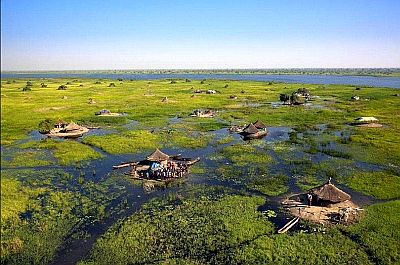 As the website www.climatestotravel.com explains, “…in some areas crossed by rivers there are wetlands, including the Sudd [see photo at right], the largest swamp in the world, situated in the north along the White Nile and its tributaries, which are lost in a myriad of lakes, canals, lagoons, covered with aquatic plants and inhabited by a large number of species of land animals and birds. The summer rains increase the surface of the flooded areas.”The official language of South Sudan is English. But Arabic is a frequently used as a 2nd semi-official language, since it is the official language of Sudan. But the people of South Sudan are a diverse collection of communities. There are over a dozen ethnic groups, sometimes referred to as “tribes,” each of which has its own language, traditions, and history. The Dinka are the largest ethnic group, making up as much as 30% of the population. The next largest group are the Nuer, who comprise about 15% of the total. There are least a dozen other ethnic groups, such as the Shiluk, the Azande, and even self-identified Arabs.
As the website www.climatestotravel.com explains, “…in some areas crossed by rivers there are wetlands, including the Sudd [see photo at right], the largest swamp in the world, situated in the north along the White Nile and its tributaries, which are lost in a myriad of lakes, canals, lagoons, covered with aquatic plants and inhabited by a large number of species of land animals and birds. The summer rains increase the surface of the flooded areas.”The official language of South Sudan is English. But Arabic is a frequently used as a 2nd semi-official language, since it is the official language of Sudan. But the people of South Sudan are a diverse collection of communities. There are over a dozen ethnic groups, sometimes referred to as “tribes,” each of which has its own language, traditions, and history. The Dinka are the largest ethnic group, making up as much as 30% of the population. The next largest group are the Nuer, who comprise about 15% of the total. There are least a dozen other ethnic groups, such as the Shiluk, the Azande, and even self-identified Arabs.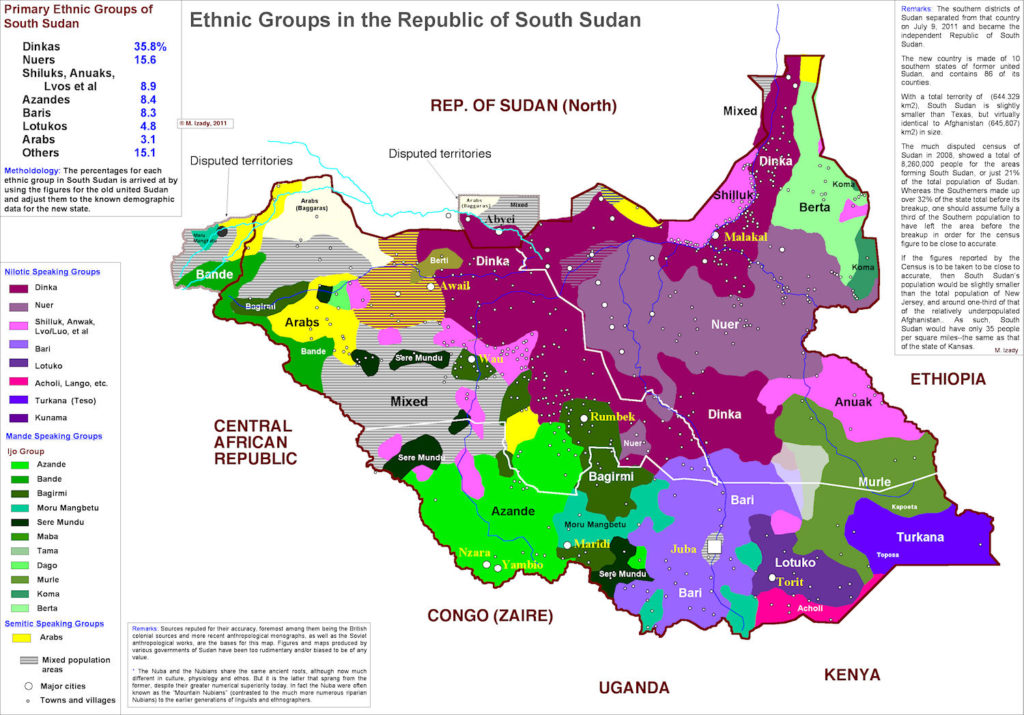 The diversity of ethnicity and local languages is overlayed with a mixture of religious practice, ranging from traditional “animist” beliefs, Christianity–which was introduced during the British colonial period–and Islam, principally among peoples living along the border with Sudan to the North where Islam is the dominant religion.
The diversity of ethnicity and local languages is overlayed with a mixture of religious practice, ranging from traditional “animist” beliefs, Christianity–which was introduced during the British colonial period–and Islam, principally among peoples living along the border with Sudan to the North where Islam is the dominant religion.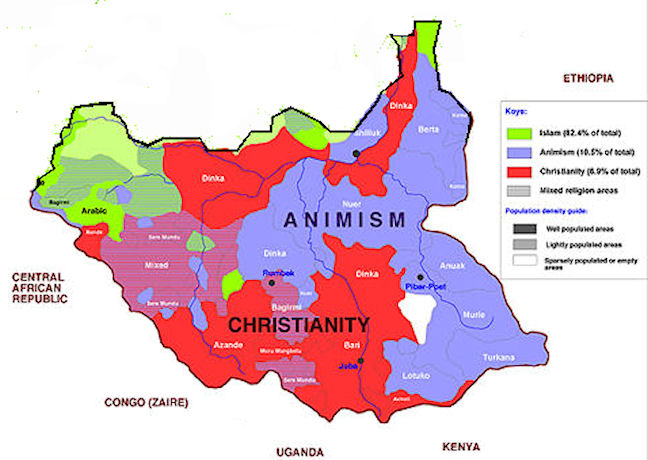 The important thing to understand is that South Sudan is a complex mosaic of peoples who all want peace and prosperity, but may not agree on how to get there. As with many post-colonial nations, South Sudan’s politics reflects, and sometimes exacerbates, tensions between different ethnic and religious groups. Their constitution created a presidential republic with two houses of legislature. However, the struggle to balance the interests of competing ethnic groups continues. One summary of the current situation, with the author’s own opinions, appears here. A longer article with more details appears here.Finally, it is important to understand that in addition to a colonial history, a history as part of the original Sudan (governed by Arabic-speaking Muslims from North Sudan), and a diverse ethnic and religious make-up, South Sudan is home to large deposits of oil. The competition to control access to oil fields contributed to the fighting and violence that led to South Sudan’s independence from the North. But it is also one of the factors leading to the new nation’s civil war and continuing inter-tribal fighting since independence. The people of South Sudan have lived with fighting and conflict of various types for over twenty years. Today millions of people are still displaced from their home villages or living in refugee camps in neighboring countries.
The important thing to understand is that South Sudan is a complex mosaic of peoples who all want peace and prosperity, but may not agree on how to get there. As with many post-colonial nations, South Sudan’s politics reflects, and sometimes exacerbates, tensions between different ethnic and religious groups. Their constitution created a presidential republic with two houses of legislature. However, the struggle to balance the interests of competing ethnic groups continues. One summary of the current situation, with the author’s own opinions, appears here. A longer article with more details appears here.Finally, it is important to understand that in addition to a colonial history, a history as part of the original Sudan (governed by Arabic-speaking Muslims from North Sudan), and a diverse ethnic and religious make-up, South Sudan is home to large deposits of oil. The competition to control access to oil fields contributed to the fighting and violence that led to South Sudan’s independence from the North. But it is also one of the factors leading to the new nation’s civil war and continuing inter-tribal fighting since independence. The people of South Sudan have lived with fighting and conflict of various types for over twenty years. Today millions of people are still displaced from their home villages or living in refugee camps in neighboring countries.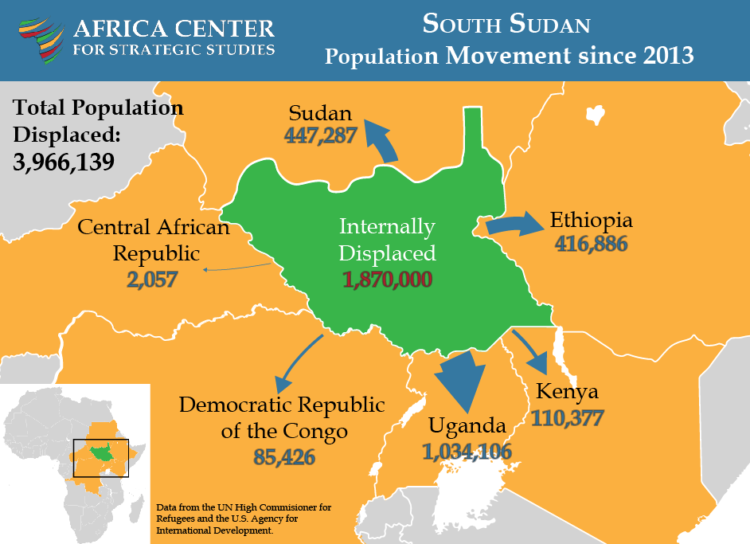 This brief summary should illustrate the wide range of challenges facing the people of South Sudan and those of us trying to assist in the country’s development. The rate of adult literacy is only about 30% (higher among men than women), employment outside of traditional cattle-herding and agriculture is very low, and investment in infrastructure such as roads and bridges is very limited. For more information on any of the topics covered in this article, we suggest you follow one of the source links for the maps and illustrations above.Africa Sunrise Communities is focusing its efforts at a very local level to give children in Bor town, Jonglei State, access to education. We support the efforts of other international agencies and local leaders to solve the larger problems of armed conflict, feeding and resettling refugees, and developing the economy of South Sudan. For more information about our work so far, see other blog posts on our website. To support us, visit our Get Involved page and share our news with your friends on Facebook and Twitter._________________________________________________________Follow us on Facebook and Twitter (@africa_sunrise).
This brief summary should illustrate the wide range of challenges facing the people of South Sudan and those of us trying to assist in the country’s development. The rate of adult literacy is only about 30% (higher among men than women), employment outside of traditional cattle-herding and agriculture is very low, and investment in infrastructure such as roads and bridges is very limited. For more information on any of the topics covered in this article, we suggest you follow one of the source links for the maps and illustrations above.Africa Sunrise Communities is focusing its efforts at a very local level to give children in Bor town, Jonglei State, access to education. We support the efforts of other international agencies and local leaders to solve the larger problems of armed conflict, feeding and resettling refugees, and developing the economy of South Sudan. For more information about our work so far, see other blog posts on our website. To support us, visit our Get Involved page and share our news with your friends on Facebook and Twitter._________________________________________________________Follow us on Facebook and Twitter (@africa_sunrise).
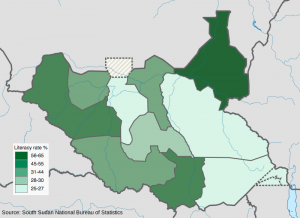 In the new nation of South Sudan, war has prevented fully one-half of the children from going to school.
In the new nation of South Sudan, war has prevented fully one-half of the children from going to school.